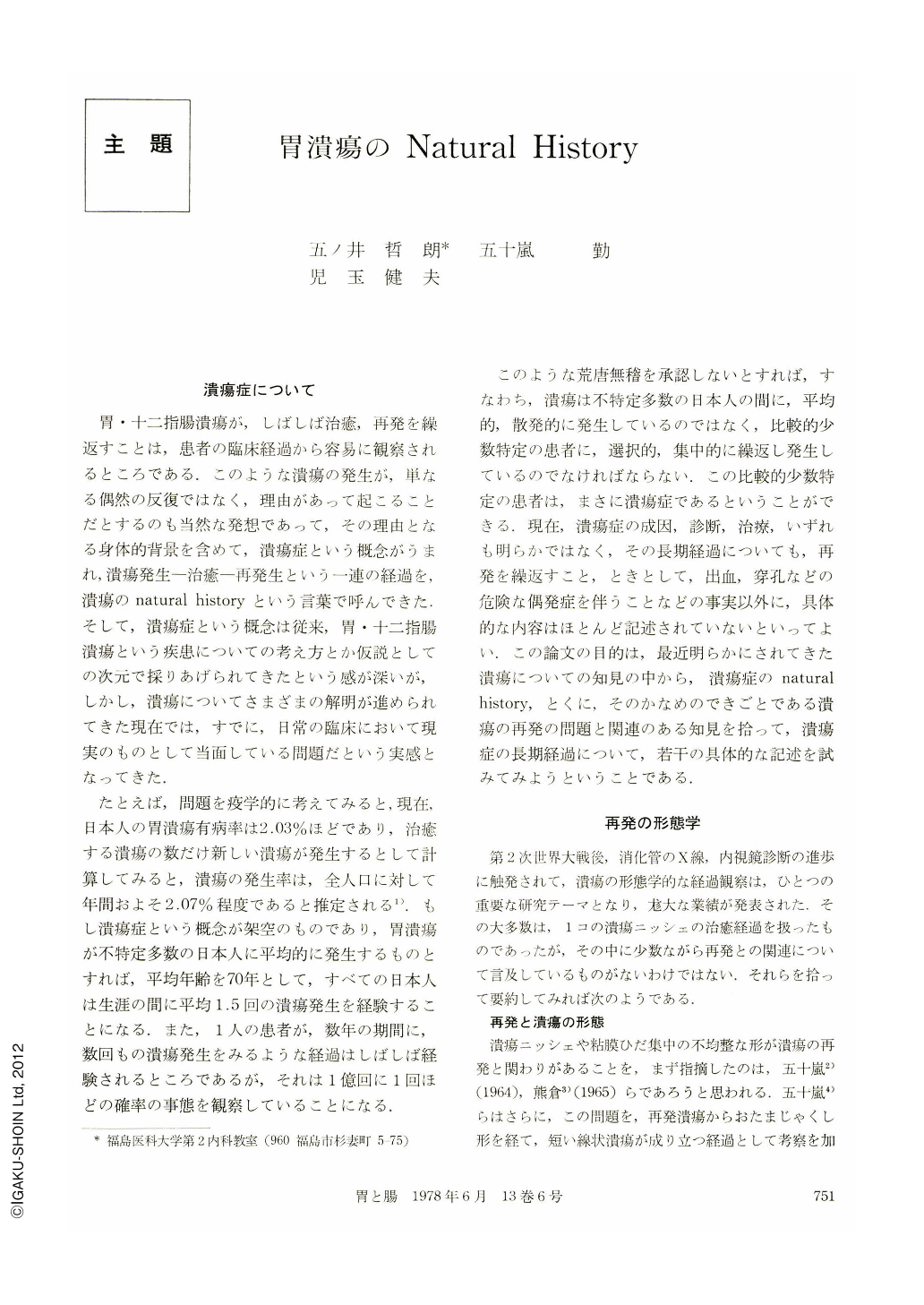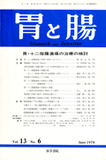Japanese
English
- 有料閲覧
- Abstract 文献概要
- 1ページ目 Look Inside
潰瘍症について
胃・十二指腸潰瘍が,しばしば治癒,再発を繰返すことは,患者の臨床経過から容易に観察されるところである.このような潰瘍の発生が,単なる偶然の反復ではなく,理由があって起こることだとするのも当然な発想であって,その理由となる身体的背景を含めて,潰瘍症という概念がうまれ,潰瘍発生―治癒―再発生という一連の経過を,潰瘍のnatural historyという言葉で呼んできた.そして,潰瘍症という概念は従来,胃・十二指腸潰瘍という疾患についての考え方とか仮説としての次元で採りあげられてきたという感が深いが,しかし,潰瘍についてさまざまの解明が進められてきた現在では,すでに,日常の臨床において現実のものとして当面している問題だという実感となってきた.
たとえば,問題を疫学的に考えてみると,現在,日本人の胃潰瘍有病率は2.03%ほどであり,治癒する潰瘍の数だけ新しい潰瘍が発生するとして計算してみると,潰瘍の発生率は,全人口に対して年間およそ2.07%程度であると推定される1).もし潰瘍症という概念が架空のものであり,胃潰瘍が不特定多数の日本人に平均的に発生するものとすれば,平均年齢を70年として,すべての日本人は生涯の間に平均1.5回の潰瘍発生を経験することになる.また,1人の患者が,数年の期間に,数回もの潰瘍発生をみるような経過はしばしば経験されるところであるが,それは1億回に1回ほどの確率の事態を観察していることになる.
The frequent recurrence of gastric and duodenal ulcers is a well-known fact. When attempts are made to study gastric and duodenal ulcers not from the course of a single occurrence but from a prolonged natural history including recurrence, the term “ulcer disease” is used. While the concept of “ulcer disease” is presently used as a term, hardly any actual content is described except for the repeated recurrence. In other words, the natural history of gastric and duodenal ulcers has not been clearer determined.
Since the World War Ⅱ, Y-ray and endoscopic diagnosis of gastric diseases has made remarkable progress in Japan. Many new reports appeared on the clinical course of ulcers. Most of these have dealt with the course of healing of a single ulcer niche or a single course of ulcer. A few reports, however, gave interesting and suggestive information in the consideration of its natural history. Through a review of these studies, attempts were made to describe the natural history of ulcers.
As a morphological problem to begin with, ulcer recurrence is not siLnply the repeated occurrence and healing of a similar ulcer, but more complex. The scar of the preceding ulcer influences the shape and course of healing of the recurrent ulcer and the healing of this ulcer changes the shape of the preexisting scar zone. This is related to the mechanism of develpment of ulcers of irregular shape, linear scar and broad scar. Elucidation of the course of repeated recurrences and the progress of ulcers thus appears to be started. Further studies are indicated on the detailed pattern of development and the characteristics according to the site of occurrence.
As an epidemiological problem, it became possible to analyze the actual mode of recurrence of ulcers in considerable detail. According to the summary of these results, ulcers recur over a long period after healing and the probability of recurrence is constant regardless of the course after healing. As a result, the cumulative incidence rises in terms of an exponential function along with the course in years, reaching 47% in 5 years, 68% in 10 years and 89% in 20 years. From these results, many important suggestions were obtained on the natural history of gastric and duodenal ulcers. The property of repeated recurrence is an important characteristic of gastroduodenal ulcers. A group of gastrointestinal ulcerations without recurrence as a rule should therefore be distinguished from gastric and duodenal ulcers. In view of the natural history, healing of a gastrointestinal ulcer or escape from “ulcer disease”cannot be expected with assurance. In adults, most of the ulcers detected in daily practice are already recurrent ulcers. From epidemiological viewpoints, gastric and duodenal ulcers do not occur s oradically in a large number of patients, but occur reneatedly in a rather small number of specific patients or patients with ulcer disease. From such a viewpoint, it is possible to describe the epidemiology of ulcer disease concretely, though this disease has been completely out of the range of such studies so far.
As a clinical problem furthermore, no method has yet been established to make the diagnosis of ulcer disease without an ulcer niche and no method of treatment is available for ulcer disease. We should reflect on the strange confusion of the entire clinical aspect of gastric and duodenal ulcers for this reason.

Copyright © 1978, Igaku-Shoin Ltd. All rights reserved.


